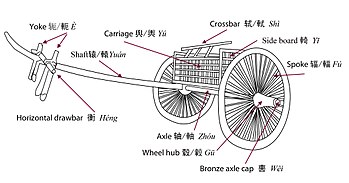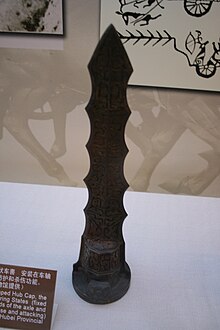Chariots in ancient China
| Chariots in ancient China | |||||||
|---|---|---|---|---|---|---|---|
 A Chinese chariot (c. 400 BCE) | |||||||
| Traditional Chinese | |||||||
| Literal meaning | war vehicle | ||||||
| |||||||
The ancient Chinese chariot (traditional Chinese:
History
[edit]

Traditional sources attribute the invention of the chariot to the Xia dynasty minister Xi Zhong,[4][5][6] and say they were used at the Battle of Gan (
Chariots reached their apogee[11] and remained a powerful weapon until the end of the Warring States period (471–221 BCE) when increasing use of the crossbow, massed infantry, the adoption of standard cavalry units and the adaptation of nomadic cavalry (mounted archery) took over. Chariots continued to serve as command posts for officers during the Qin and Han dynasties while armored chariots were also used by the Han dynasty against the Xiongnu Confederation in the Han–Xiongnu War, specifically at the Battle of Mobei in 119 CE. General Wei Qing's army, setting off from Dingxiang,[12] encountered the Xiongnu Chanyu's army of 80,000 cavalry. Wei Qing ordered his troops to arrange heavy-armored chariots in a ring formation,[12] creating mobile fortresses.
With changes in the nature of warfare, as well as the increasing availability of larger breeds of horses, during the Qin and Han dynasties (221 BCE – 220 CE) the chariot was replaced by cavalry and infantry, and the single-pole chariot became less important. At this time the double shaft chariot developed as a transport vehicle which was light and easy to handle. During the Eastern Han (25–220 CE) and later during the Three Kingdoms period (220–280 CE), the double shaft chariot was the predominant form. This change is seen in innumerable Han dynasty stone carvings and in many ceramic tomb models. Over time, as society evolved, the early chariot of the Pre-Qin period gradually disappeared.[13]
Construction
[edit]

Ancient Chinese chariots were typically two wheeled vehicles drawn by two or four horses[14] with a single draught pole measuring around 3 m long that was originally straight but later evolved into two curved shafts. At the front end of the pole there was a horizontal draw-bar about one meter long with wooden yokes attached, to which the horses would be harnessed. Wooden wheels with a diameter of between approximately 1.2 – 1.4 m were mounted on a three-meter-long (9.8 ft) axle and secured at each end with a bronze hubcap. Wheels of the Shang period usually had 18 spokes, but those of the Zhou period numbered from 18 to 26. Chariot wheels of the Spring and Autumn period (8th–7th century BCE) had between 25 and 28 spokes. The carriage body was around one meter long and 0.8 meters wide with wooden walls and an opening at the back to provide access for soldiers.[15][13]
With the arrival of the Spring and Autumn period (771–476 BCE) improvements had been made to the chariot's design and construction. The angle of the curved draw pole had increased raising the end of the pole. This reduced the amount of effort required by the horse pulling the chariot and increased its speed. The width of the carriage body had also increased to around 1.5 m allowing soldiers greater freedom of movement. Key components such as the pole, hubcap and yoke were reinforced with decorated copper castings, increasing the chariot's stability and durability. These chariots were variously referred to as "gold chariots" (
The Chinese war chariot, like the other war chariots of Eurasia, derived its characteristic ability to perform at high speed by a combination of a light design, together with a propulsion system using horses, which were the fastest draft animals available.[16]
Crew and weaponry
[edit]
Usually a chariot carried three armored warriors with different tasks: one, known as the charioteer (
The most important close-combat weapon aboard the chariot was the dagger-axe or gē (
All chariot commanders carried a bronze dagger for protection in the case of the chariot becoming unserviceable or an enemy jumping on board the chariot. Soldiers aboard wore leather or occasionally copper armour and carried a shield or dùn (
Operational deployment
[edit]The chariot was a large military vehicle that through its lack of flexibility was not effective as a single combat unit.[15] Usually its commander would be allocated a number of infantrymen or tú zù (
Combat and tactical disposition
[edit]


In ancient China the chariot was used in a primary role from the time of the Shang dynasty until the early years of the Han dynasty (c. 1200–200 BCE) when it was replaced by cavalry and fell back into a secondary support role. For a millennium or more, every chariot borne soldier had used the particular combat tactics that use of the vehicle required.
Chariot-based combat usually took place in wide-open spaces. When the two sides were within range, they would first exchange arrow or crossbow fire, hoping that through superior numbers they would cause disorder and confusion in the enemy ranks. As the two opponents closed on each other they would stay about four meters apart to avoid the three-meter-long (9.8 ft) dagger-axes of their opponents. Only when two chariots came closer than this would an actual fight occur.
Only about three meters wide, with infantry riding on both sides, the chariot was highly inflexible as a fighting machine and difficult to turn around. Coupled with this were restrictions on the use of weapons with opponents seizing the momentary opportunity for victory or trapping their opponent with a pincer movement. These tactics required fighting in tight formation with good military discipline and control. When the spring and autumn period began, more attention was paid to troop formations according to the type of battle. Chariot units were trained to ensure co-ordination with the rest of the army during a military campaign.
During the Western Zhou Era, chariots were deployed on wide-open plains abreast of each other in a single line. The accompanying infantry would then be deployed forward of the chariot, a broad formation that denied the enemy the opportunity for pincer attacks. When the two sides clashed, if the chariots remained in strict formation there would be a good opportunity to encircle the enemy. During this period of chariot warfare, the use of orderly team-based combat to some extent determined the difference between victory and defeat, otherwise fighting would have to stop in order to consolidate the formation. In this type operation unified command was important. Senior officers would use drums and flags to command the army's advance and retreat, speed and to make formation adjustments. However such operations were inherently very slow-paced and the speed of engagement thus hampered. Furthermore, the infantry had to remain in line which was not conducive to long-distance pursuits of retreating enemies.

A typical example of the importance of disciplined forces occurred during the Zhou overthrow of Shang at the decisive Battle of Muye in 1046 BCE. As the Zhou army moved forward, the infantry and chariots were commanded to stop and regroup after every six or seven steps to maintain formation. The Shang army, despite its superior numbers, was largely composed of demoralized and forcibly conscripted troops. As a result, the troops failed to stay in formation and were defeated.[15]
As the Spring and Autumn period dawned, chariots remained the key to victory. At the Battle of Yanling in 575 BCE between the States of Chu and Jin the disorganized nature of the Chu army's chariots and infantry led to its defeat. Both troop formations and the flexibility of the chariot subsequently underwent major developments with infantry placing a much larger role in combat. Troops were no longer deployed forward of chariots but instead around all four sides thereby increasing the vehicle's flexibility. Formations no longer involved a single line of chariots; instead they were spread out which brought the advantage of depth. In this way the chariot's movement was no longer impeded so it could counter enemy attacks as well as provide a fast pursuit vehicle.
See also
[edit]References
[edit]Citations
[edit]- ^ a b Rawson, Jessica (June 2020). "Chariotry and Prone Burials: Reassessing Late Shang China's Relationship with Its Northern Neighbours". Journal of World Prehistory. 33 (2): 135–168. doi:10.1007/s10963-020-09142-4. S2CID 254751158.
These different monuments, petroglyphs, khirigsuurs and deer stones have illuminated the key role of the Mongolia plateau as a major region of origin for chariot and horse use in East Asia (and their associated weapons and tools), and also the likely source for the chariots and horses employed at Anyang
- ^ a b Shaughnessy, Edward L. (1988). "Historical Perspectives on The Introduction of The Chariot Into China". Harvard Journal of Asiatic Studies. 48 (1): 189–237. doi:10.2307/2719276. ISSN 0073-0548. JSTOR 2719276.
Recent publications of archeological discoveries throughout Soviet Central Asia, however, now allow the previous void between China and the Near East to be filled both spatially and temporally, leaving no doubt that the chariot did indeed enter China from the northwest at about 1200 B.C. (...) From this we might suggest an upper limit for artifactual evidence of the chariot in China of about 1200 B.C., which corresponds to the last part of King Wu Ding's reign (c. 1200-1180 B.C.).
- ^ a b Barbieri-Low, Anthony J. (February 2000). "Wheeled Vehicles in the Chinese Bronze Age (c. 2000-741 B.C.)" (PDF). Sino-Platonic Papers. 99.
- ^ Xu Shen. "Radical
車 ". Shuowen Jiezi.車 :輿 輪 之 緫名。夏 后 時 奚仲所 造 。 - ^ "Chapter on Inventions (
作 篇 ) - Xia (夏 )". Shiben.奚仲
作 車 。 - ^ Guyi congshu 11, Yupian, vol. 1, Chariot Section (
車 部 ). quote: "世 本 奚仲作 車 宋 忠 曰夏禹時人 也". p. 132 of 157 scanned and transcribed by Chinese Text Project - ^ Beckwith 2009, p. 43.
- ^ Ebrey, Patricia Buckley; Walthall, Anne; Palais, James B. (2006). East Asia: A Cultural, Social, and Political History. Boston: Houghton Mifflin Company. p. 14. ISBN 978-0-618-13384-0.
- ^ Woolf, Greg (2007). Ancient civilizations: the illustrated guide to belief, mythology, and art. Barnes & Noble. p. 227. ISBN 978-1-4351-0121-0.
- ^ Shaughnessy, Edward L. (1988). "Historical Perspectives on The Introduction of The Chariot Into China". Harvard Journal of Asiatic Studies. 48 (1): 189–237. doi:10.2307/2719276. JSTOR 2719276.
- ^ "Excavation of Zhou Dynasty Chariot Tombs Reveals More About Ancient Chinese Society". People's Daily. Beijing: People's Daily Online. 16 March 2002. Retrieved 10 October 2010.
- ^ a b Whiting, Marvin C. (2002). Imperial Chinese military history: 8000BC-1912AD. Lincoln: iUniverse, Inc. pp. 154–155. ISBN 978-0-595-22134-9.
- ^ a b Lu Liancheng (1 December 1993). "Chariot and horse burials in ancient China". Antiquity. 67 (257): 824–838. doi:10.1017/S0003598X0006381X. S2CID 160406060. Archived from the original on 21 October 2012. Retrieved 6 December 2022 – via The Free Library.
- ^ Gernet 1996, p. 51.
- ^ a b c d e f "
中国 古代 战争的 凶猛 利器 :古代 战车及车战" [Fierce and effective weapons of Ancient China: Chariots and Chariot Warfare]. China.com (in Chinese). 17 July 2008. Archived from the original on 17 July 2011. Retrieved 6 October 2010. - ^ Beckwith 2009, p. 53 (note: although Beckwith is making a general statement about war chariots in general, this also is explicitly tied to the Chinese war chariot elsewhere in the text)
- ^ "Weapons of the Warring States Period" (in Chinese). Archived from the original on 7 July 2011. Retrieved 8 October 2010.
Bibliography
[edit]- Beckwith, Christopher I. (2009). Empires of the Silk Road: A History of Central Eurasia from the Bronze Age to the Present. Princeton: Princeton University Press. ISBN 978-0-691-13589-2.
- Gernet, Jacques (1996). A History of Chinese Civilization (2nd ed.). Cambridge University Press. ISBN 0-521-49781-7.
